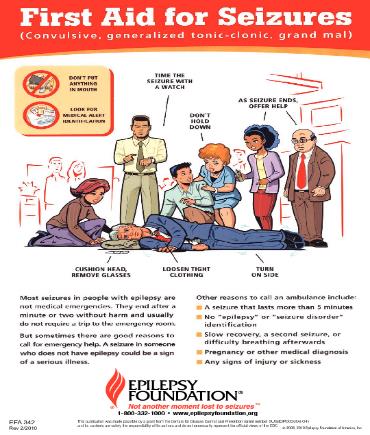Written by Debbra A. Livingston MSN, ARNP, BC – Jacksonville District
Seizures are uncontrolled electrical activity in the brain, which may produce a physical convulsion, minor physical signs, thought disturbances, or a combination of symptoms.

The type of symptoms and seizures depend on where the abnormal electrical activity takes place in the brain, what its cause is, and such factors as the patient's age and general state of health. Seizures can be caused by head injuries, brain tumors, lead poisoning, wrongly development of the brain, genetic and infectious illnesses, and fevers. In fully half of the patients with seizures, no cause can yet be found.
How you react when someone is having a seizure can make a difference by following a few simple, common sense guidelines.

1 – First, stay calm.
2 – Make sure there is nothing that can harm the person having a seizure. Make sure his/her head is protected from hard surfaces. Use a pillow, article of clothing, etc. to protect the head.
3 – Help the person lie on their side to avoid choking on saliva or vomitus.
4 – If you have a watch, time the length of the seizure (shaking phase).
5 – Never try to restrain the person or hold the person time. Try to restrain the person may cause harm to the person or to you. Please request that all bystanders STAND BACK. Hovering over any one suffering a critical events will decrease the oxygen level for all involved.
6 – Never, ever put anything in the mouth of a seizing person. Doing so may break teeth and/or block airway.
7 – Don’t try to give the person water, food or medicine until he/she is fully awake and responsive.
8 – Call 911 if the seizure lasts greater than 5 minutes or if the person has injuries.
Some people think that a person having a seizure can swallow his/her tongue. That is a myth!!! It is impossible to swallow your tongue.
It has also been thought down through the years that a person with seizures is evil or demon possessed. This is also a myth!!!
Epilepsy (seizures) is a true neurological disorder identifies by abnormal activity in the brain.

References:


